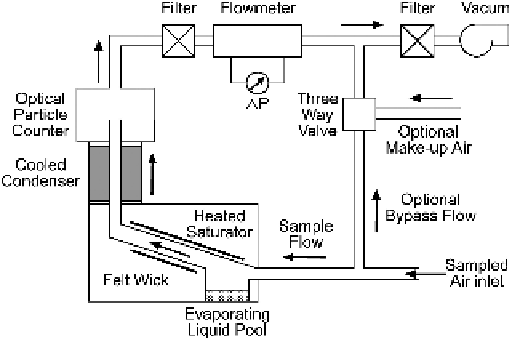Environmental Engineering Reference
In-Depth Information
Figure 5.10
Schematic of a condensation particle counter (CPC).
fi ve micrometres diameter. However, measurements of particle size distributions
indicate that typically around 80% of airborne particles by number in urban air
are within the size range below 100 nanometres diameter and therefore the mea-
surement of the condensation particle counter is an excellent refl ection of the
ultrafi ne particle number concentration.
There are a number of aerosol size spectrometer instruments based upon particle
separation followed by detection by the condensation particle counter. These gen-
erally go under the name of Differential Mobility Particle Sizer or Scanning
Mobility Particle Sizer depending upon the precise mode of instrument operation.
In the Scanning Mobility Particle Sizer, the condensation particle counter is pre-
ceded by a bipolar charger and differential mobility analyser (Figure 5.11). The
bipolar charger typically comprises a radioactive source such as
85
Kr, which leads
to both negative and positive charging of aerosol particles. The particles are then
passed into the differential mobility analyser, which involves them moving down-
wards within an annulus between a central rod and an earthed outer tube. The
central rod and outer tube are held at different electrical voltages, creating a poten-
tial gradient within the annulus. The charged particles migrate horizontally within
the electric fi eld towards the central rod and by adjusting the electric fi eld strength
the instrument can be tuned to allow only one size of particles to exit through a
slot in the base of the instrument. By ramping the voltage, a spectrum of particle
sizes is obtained. Particles exiting through the slot are counted with a condensation
particle counter and the count rate used to infer a number concentration for that
size of particle in the inlet airstream, after allowing for the effi ciency of particle
charging and transmission through the differential mobility analyser. Smaller par-
ticles acquire only a single charge (or no charge at all) in the bipolar charger but
larger particles can also acquire multiple charges. Doubly charged particles behave
in the same way as singly charged particles of half the size and, therefore, provided
the relative effi ciencies of single and multiple charging are known, a correction can

Search WWH ::

Custom Search